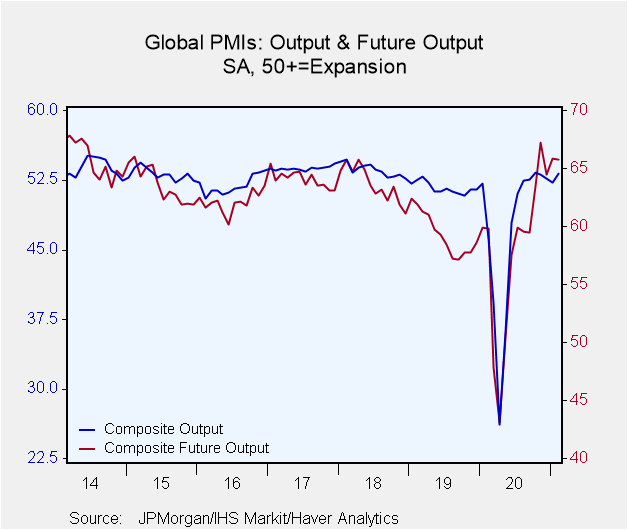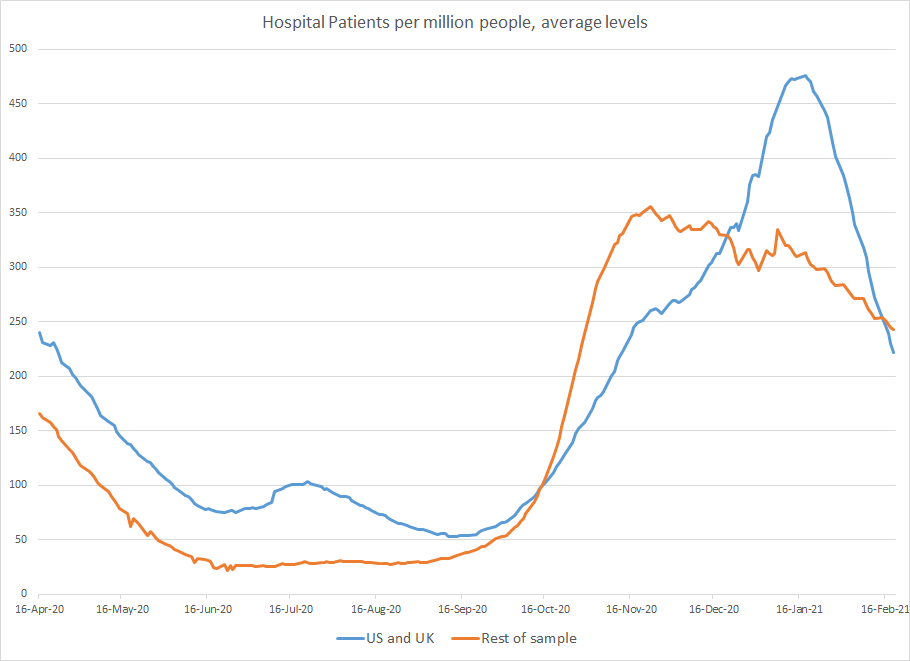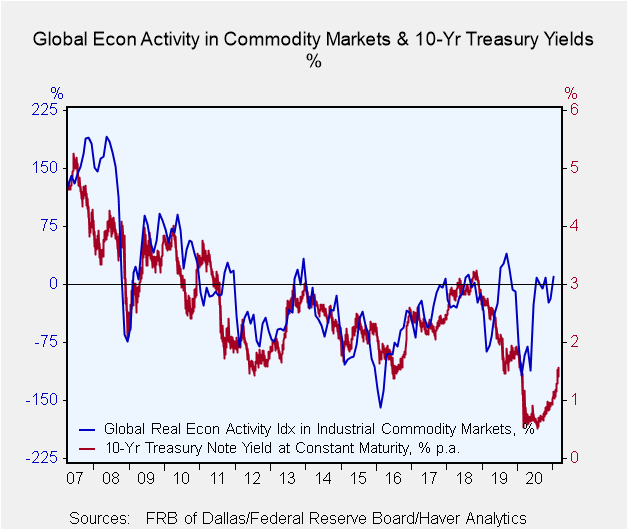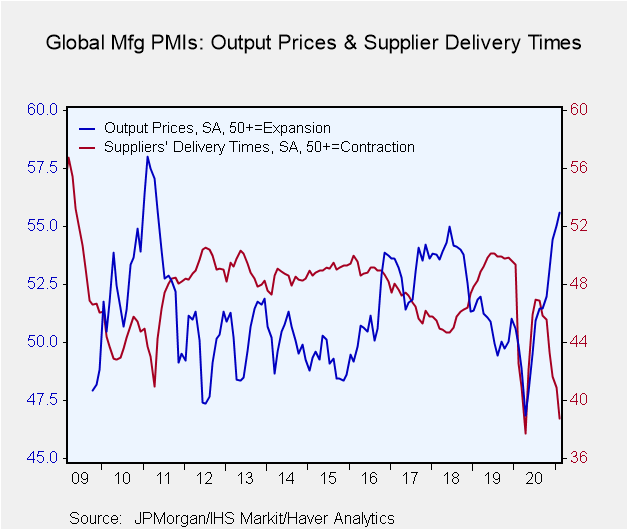 Global| Mar 08 2021
Global| Mar 08 2021Climbing the Wall of Worry
by:Andrew Cates
|in:Viewpoints
Summary
Financial markets have clearly become much more unsettled in recent weeks. Growing concerns about inflation risks and how Central Banks might respond to prospective price pressures seem to be top of the worry list. And rising long- [...]
Financial markets have clearly become much more unsettled in recent weeks. Growing concerns about inflation risks and how Central Banks might respond to prospective price pressures seem to be top of the worry list. And rising long-term interest rates are clearly reflecting these concerns. The economic instability that higher interest rates might portend are another important dimension that's been undermining confidence.
Much of the recent price action in financial markets, however, could reflect a more straightforward – and less concerning – normalisation of the world economy. In this narrative, global growth – having been suppressed at multi-decade lows – is now poised to rebound and rebound quite strongly. Rather than just reflecting inflation angst, longer-term interest rates are therefore climbing too to match the likely increased demand for capital that firmer growth expectations should yield. While that adjustment process perhaps naturally generates some financial instability as expectations are being re-set and valuations are adjusting it need not necessarily trigger meaningful economic instability so long as the world economy's recovery foundations remain solid.
Putting this another way, there is scant evidence at present to suggest the world economy is poised to enter an over-heating phase. If current price pressures are, in part at least, a manifestation of supply side bottlenecks that are, in turn, a consequence of the pandemic, then as the pandemic eases those bottlenecks should ease as well.
In what follows we highlight a few charts that reinforce the thrust of this straightforward message.
Firstly on the world economy's impending recovery (or normalisation) the latest raft of purchasing managers' surveys have been encouraging. At the global level the headline output balance inched up to 53.2 in February, its highest level since last October. And that's notwithstanding acute lockdown stringency in a number of European (and other) countries. Expectations for future output growth, moreover, remained at relatively high levels in most major countries (see figure 1 below).
Figure 1: Global composite PMI inched up to a relatively high level in February
This optimism about recovery prospects hinges in part of course on vaccine efficacy and how that in turn removes fear and ignites confidence. There have been a number of formal studies already that highlight how effective a number of vaccines have been in choking off transmission and reigning back case numbers and fatalities. The fairly dramatic decline in hospital admissions in countries such as the US and UK (which have vaccinated relatively heavily) is noteworthy here relative to the far more muted decline in hospitalisation rates in countries that have not been vaccinated as heavily (see figure 2 below). This should mean that as more of the world's population is vaccinated the swifter the return to normality for the world economy.
Figure 2: Hospital patients in the US and UK
Source: University of Oxford/Haver Analytics
Against these fundamental considerations then how does the rise in bond yields square? An intriguing chart that puts recent moves into context is shown in figure 3 below. It compares the yield on 10 year US Treasuries with an index that's designed to measure the pace of global economic activity in commodity markets. The latter is calculated by the Dallas Fed and derived from a panel of dollar-denominated global bulk dry cargo shipping rates. It may be viewed therefore as a proxy for the volume of shipping in industrial commodity markets.
Figure 3: Global economic activity in commodity markets versus US 10 year Treasury yields
The chart is intriguing because the correlation between the two variables – until recently – has been impressive (around 75% from 2007 to 2020). It's intriguing though as well because some of the recent concerns about inflation stem in part from firmer commodity prices. It's admittedly still difficult to draw strong conclusions from this because in theory there are many moving parts to gyrations in bond yields. The chart nevertheless suggests that yields still appear to be quite low relative to the measured pace of activity in industrial commodities in recent weeks. Indeed the recent climb in yields looks entirely warranted relative to the rebound in activity and that a further increase ought to not necessarily come as a big surprise. That said ultra-loose monetary policy – and Central Banks' bond buying programmes in particular – are a key factor that are suppressing long rates relative to the underlying pace of economic growth. Absent any major shift in these policies – which seems unlikely based on recent rhetoric – and a further sharp upward shift in long term rates seems unlikely.
The still unanswered element to this though is the degree to which firmer activity in these commodity markets heralds higher inflation in the period ahead. To some extent that seems inevitable given the strong links between higher oil prices and the energy components of headline consumer prices. There are some base effects from the plunge in activity - and some prices – that took place last year that will equally put upward pressure on CPI inflation in the coming months. As we discussed in our last commentary (see Inflation Fears Are Probably Over-stated) what really matters now is how second round effects on wages and inflation expectations now play out. And that will largely hinge on issues such as spare capacity.
On that score though there was further evidence in the detail of the recent raft of purchasing managers' surveys that suggest inflation fears may be over-stated. For example much of the recent sharp climb in the output price component of these surveys coincided with supply chain disruption and delivery delays as well as rising cost inflation. Indeed average supplier lead times lengthened to the second greatest extent in the global manufacturing survey's history with almost all of the nations covered reporting an increase (see figure 4 below).
This supply chain pressure though has not – judging by other components of this index – been a manifestation of soaring demand. Instead it seems much more likely to have been a consequence of the pandemic and the tighter restrictions that have been placed on the movement of factors of production (including labour).
Figure 4: Global manufacturing PMI: Output prices and supplier delivery times
If that's right it implies that as vaccines take effect, as fear unwinds, and as government lockdown restrictions ease these supply chain pressures also ought to ease. Indeed just as the onset of the pandemic triggered both a negative demand and a negative supply shock so the easing of the pandemic ought to trigger a positive demand and a positive supply response. And the latter ought to mitigate some of the inflationary consequences that could stem from the former.
Viewpoint commentaries are the opinions of the author and do not reflect the views of Haver Analytics.Andrew Cates
AuthorMore in Author Profile »Andy Cates joined Haver Analytics as a Senior Economist in 2020. Andy has more than 25 years of experience forecasting the global economic outlook and in assessing the implications for policy settings and financial markets. He has held various senior positions in London in a number of Investment Banks including as Head of Developed Markets Economics at Nomura and as Chief Eurozone Economist at RBS. These followed a spell of 21 years as Senior International Economist at UBS, 5 of which were spent in Singapore. Prior to his time in financial services Andy was a UK economist at HM Treasury in London holding positions in the domestic forecasting and macroeconomic modelling units. He has a BA in Economics from the University of York and an MSc in Economics and Econometrics from the University of Southampton.






